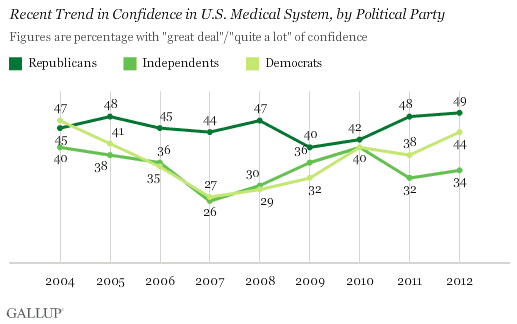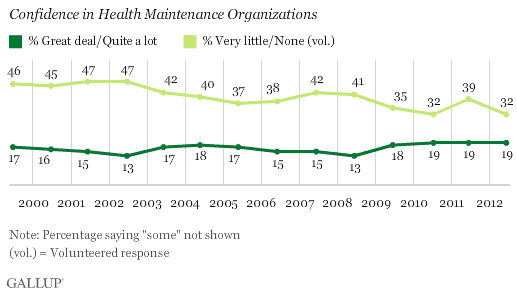PRINCETON, NJ -- Forty-one percent of Americans tell Gallup they have a great deal or quite a lot of confidence in the U.S. medical system. Americans' confidence has been a bit higher since the Patient Protection and Affordable Care Act passed in 2010, and is much higher than the 2007 low point.

Though confidence in the medical system is up, it is only slightly better than the historical average of 39%. This confidence rate has fluctuated in a fairly narrow range between 31% and 44% since 1993, and has always exceeded the percentage expressing "very little" or "no" confidence. Another 33% to 42% have historically expressed "some" confidence in the medical system.
Confidence in the U.S. medical system hit a low of 31% in 2007, a year in which confidence in most U.S. institutions dropped. Confidence began to improve in 2008 and 2009, though it remained below the historical average. In 2010, after President Obama signed comprehensive U.S. healthcare reform legislation, confidence improved a bit more to 40%, and has stayed at about that level -- essentially the historical average -- since then.
Americans' confidence in the medical system peaked at 44% in 2003 and 2004.
Democrats Showing Largest Increase in Confidence
Republicans have typically shown greater confidence in the medical system than independents or Democrats, and that is the case today. Currently, 49% of Republicans have a great deal or quite a lot of confidence in the medical system, compared with 44% of Democrats and 34% of independents.
Republicans' confidence has held at or above the 40% level in recent years, including the record-low confidence year, 2007. That year, Democrats' confidence dropped to 27%, but it has shown an upward trend since then, increasing a total of 17 percentage points in the last five years. Over that same time, Republicans' confidence is up five points and independents', eight points.

Confidence in HMOs Remains Low, but Is Improved
This year, 19% of Americans say they have a great deal or quite a lot of confidence in Health Maintenance Organizations. While still low on an absolute basis -- only Congress ranks lower among the institutions Gallup measured this year -- it ties for the best HMO rating in the 14 years Gallup has measured them.
Over time, the percentage of Americans who have very little or no confidence in HMOs has declined from 47% to 32%.

HMOs did not receive a similar boost in confidence after the 2010 healthcare law passed, with 18% confident in 2009, compared with 19% in the three years afterward.
Implications
Americans' confidence in the U.S. medical system improved somewhat after the passage of the 2010 healthcare law. The law involved sweeping changes to the way healthcare is delivered and paid for in the United States, with many of the more significant changes, such as the requirement that all individuals have health insurance or pay a fine, not yet implemented.
The Supreme Court's decision on the fate of the law could arguably be as significant an event in the U.S. healthcare system as the passage of the law itself. The court will effectively decide whether the healthcare law's changes will fully take place, whether the healthcare system reverts back to what it was before the law passed, or whether some aspects of the law remain in place and others do not.
In addition to its obvious impact on the healthcare system, the decision could ultimately affect the amount of confidence Americans have in the U.S. medical system.
Survey Methods
Results for this Gallup poll are based on telephone interviews conducted June 7-10, 2012, with a random sample of 1,004 adults, aged 18 and older, living in all 50 U.S. states and the District of Columbia.
For results based on the total sample of national adults, one can say with 95% confidence that the maximum margin of sampling error is ±4 percentage points.
Interviews are conducted with respondents on landline telephones and cellular phones, with interviews conducted in Spanish for respondents who are primarily Spanish-speaking. Each sample includes a minimum quota of 400 cell phone respondents and 600 landline respondents per 1,000 national adults, with additional minimum quotas among landline respondents by region. Landline telephone numbers are chosen at random among listed telephone numbers. Cell phone numbers are selected using random-digit-dial methods. Landline respondents are chosen at random within each household on the basis of which member had the most recent birthday.
Samples are weighted by gender, age, race, Hispanic ethnicity, education, region, adults in the household, and phone status (cell phone only/landline only/both, cell phone mostly, and having an unlisted landline number). Demographic weighting targets are based on the March 2011 Current Population Survey figures for the aged 18 and older non-institutionalized population living in U.S. telephone households. All reported margins of sampling error include the computed design effects for weighting and sample design.
In addition to sampling error, question wording and practical difficulties in conducting surveys can introduce error or bias into the findings of public opinion polls.
For more details on Gallup's polling methodology, visit www.gallup.com.
